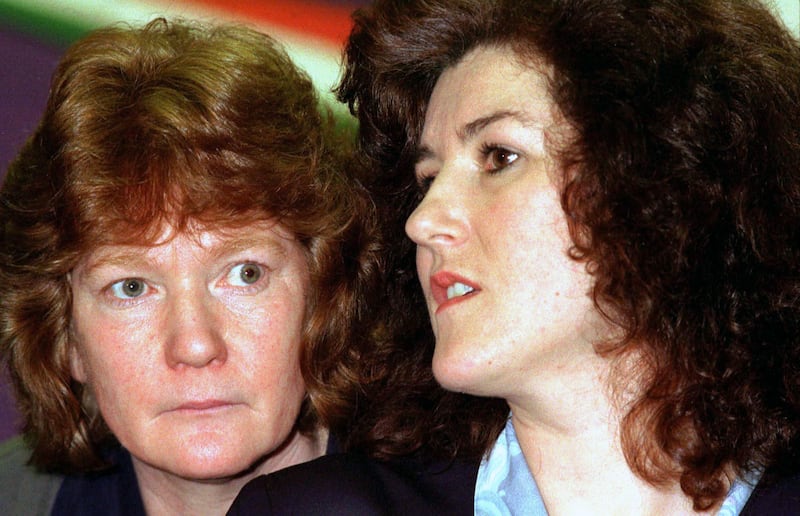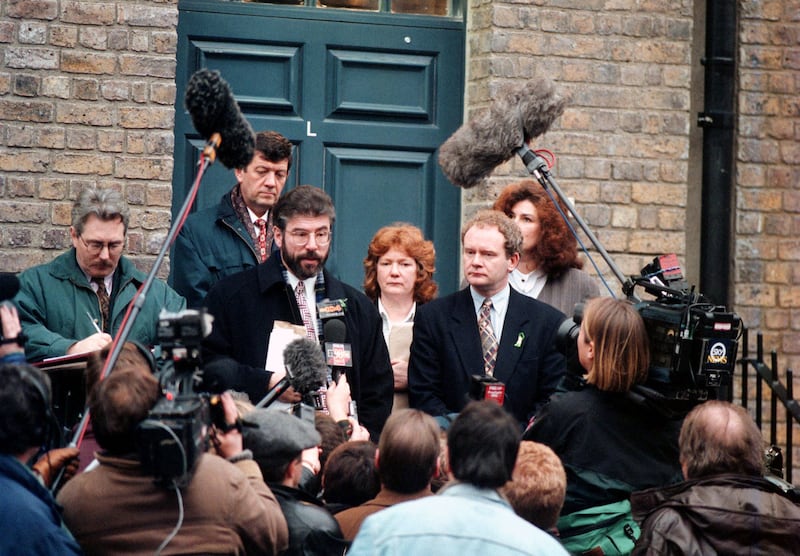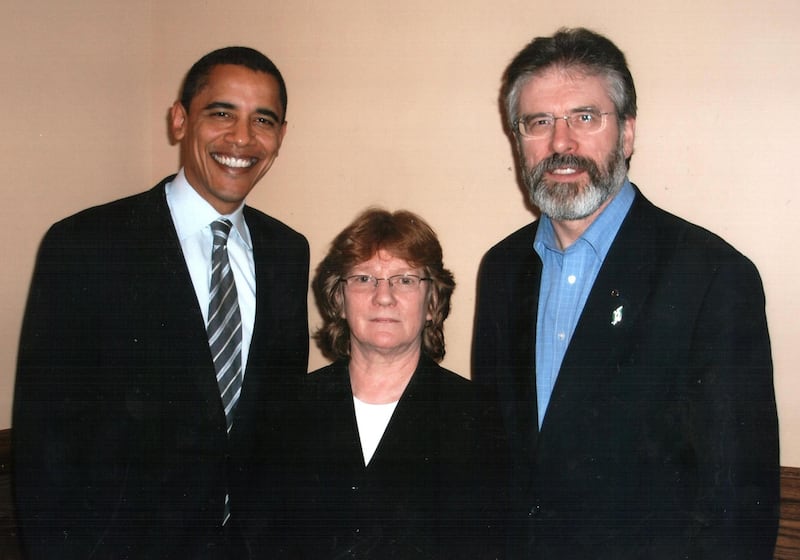Born: January 13th 1943.
Died: March 3rd 2023.
Sinn Féin president Mary Lou McDonald in her eulogy to Rita O’Hare, who has died aged 80, said she was “formidable, honourable, kind, compassionate, terrifying... fierce and acerbic”.
She described her as an “inheritor of that great tradition of unmanageable revolutionaries”, and added at the cremation service in Glasnevin on Tuesday (March 7th): “She loved people, except those that she could not stand. She did not suffer fools gladly.”
READ MORE
Depending on whom she was dealing with, one, some, many or all of these descriptions applied. O’Hare, who was originally from Andersonstown in west Belfast, but could not return there because of an attempted murder arrest warrant outstanding against her, was indeed fierce and formidable and one of the Provisional republican movement’s most senior figures.
“Armed with a striking intellect and a strategic mind and a first class work ethic Rita O’Hare was absolutely central in building Sinn Féin into the successful political movement that it is today,” McDonald also said at the service.
Again, few would disagree with that portrayal of O’Hare’s place in the rise of Sinn Féin.
In an emotional oration in Glasnevin on Tuesday former Sinn Féin president Gerry Adams said that her eleven grandchildren and nine great-grandchildren should know that she “fought for them and for their future so that we can all grow old in a free and united Ireland”. The older ones should tell the younger great grandchildren that “their granny was in the IRA, tell them she was a rebel, freedom-fighter”.

There are other descriptions of O’Hare. For many unionists and some others, she was an attempted murderer, a bomber and a figure central to the IRA’s 25-year campaign of violence. On Wednesday, DUP MP Carla Lockhart complained at a House of Commons committee about the “glorification of terrorism” when referring to that arrest warrant and her Tricolour-draped coffin being shouldered by, among others, Mary Lou McDonald and Sinn Féin vice-president Michelle O’Neill.
They told Gerry, who answered the door, that they were a volunteer short for an operation that was planned for that night. Gerry said, ‘Okay. I’ll just get my coat,’ and was quickly told, ‘It’s not you we want, Gerry, it’s Rita’
O’Hare was arrested in 1972 for the attempted murder of British army warrant officer Frazer Paton in Belfast the previous October. She was granted bail and promptly absconded to the Republic. Efforts to have her extradited failed after the Dublin High Court in 1978 ruled that the attack came under the political offence exception.
Three-year sentence
She continued her IRA activities in the South, also serving a three-year sentence in Limerick Prison on explosives charges. She was released in 1979.
She was married to another Belfast senior IRA member, the late Gerry O’Hare, who after a period in prison later became a noted Dublin-based journalist.
One former IRA member previously gave an account of members of an IRA unit calling to the O’Hare house in west Belfast in the early 1970s: “They told Gerry, who answered the door, that they were a volunteer short for an operation that was planned for that night. Gerry said, ‘Okay. I’ll just get my coat,’ and was quickly told, ‘It’s not you we want, Gerry, it’s Rita.’”
[ ‘A sad day for republicans’: Sinn Féin activist Rita O’Hare dies aged 80Opens in new window ]
Whether true or apocryphal, it nonetheless served to reflect her position within the paramilitary organisation.
That reputation, her prominence within Sinn Féin and the inability to make O’Hare face the courts in Northern Ireland rankled with many unionists.

Just last June in the House of Commons the DUP MP Ian Paisley, during a debate on controversial Troubles amnesty legislation, attempted and failed with an amendment designed to ensure people living outside the Northern Ireland jurisdiction could still be prosecuted for alleged paramilitary offences.
“If the amendment were to have a name, it would be the Rita O’Hare amendment,” he said. “Although she is not the only example, she is a very good example of the sort of person the amendment would encapsulate and capture – there are many other notorious examples, but hers is a specific example.”
Mixed marriage
She was born Rita McCulloch in 1943, the daughter of a mixed marriage. Her mother Maureen, a Catholic, came from the nationalist Short Strand area of East Belfast, while her father Billy, a Protestant was a socialist and internationalist from unionist east Belfast.
She did not attend the funerals of her parents despite the creation by Tony Blair’s government of controversial “on the runs” legislation which was designed to ensure former republican paramilitaries could return to their homes in Northern Ireland without fear of prosecution. More than 200 republicans took advantage of these letters of comfort. The irony here is that in relation to the “on the runs”, a House of Commons committee in effect said O’Hare was “the person responsible for the start of the whole process”, yet she could not or did not avail of the legislation. It seems she took to heart advice from Tony Blair’s chief of staff Jonathan Powell that if she did go home she might still be arrested.
She was a stickler for professionalism, for attention to detail and for grammar. God help you if you were that unfortunate press officer who issued a statement with a spelling mistake or a punctuation mark in the wrong place
— Mary Lou McDonald on Rita O'Hare
O’Hare held a number of senior positions in Sinn Féin. She was editor of An Phoblacht and the party’s director of publicity. She was also Sinn Féin general secretary and the party’s representative in North America. She was highly successful in pushing Sinn Féin’s cause in the US, helping to make friends with many Irish Americans who were very generous to the party.

She lobbied and networked assiduously, establishing many senior contacts in the US Senate and Congress and ensuring that when Sinn Féin leaders such as Gerry Adams visited Washington they had access to leading politicians and could be photographed in the company of the likes of presidents Barack Obama and Joe Biden.
O’Hare was hugely admired within republicanism but she was feared as well. “She demanded high standards,” said Mary Lou McDonald. “It didn’t matter if you were a grassroots activist or the president of the party. If you served the republican cause, you had to come up to the mark. She was a stickler for professionalism, for attention to detail and for grammar. God help you if you were that unfortunate press officer who issued a statement with a spelling mistake or a punctuation mark in the wrong place.”
Once at a Sinn Féin ardfheis in Dublin in later years, she observed to a journalist with whom she enjoyed reasonably friendly terms: “You know as I grow older I think I’ve mellowed.”
“Well, you weren’t that mellow to the Sun photographer you just kicked out of the conference,” he responded.
After her marriage to Gerry O’Hare ended in divorce, she later married another republican, Brendan Brownlee, also a native of Belfast and living in Dublin. She is survived by her husband, four children, her grandchildren and great-grandchildren and her brother Alan.














